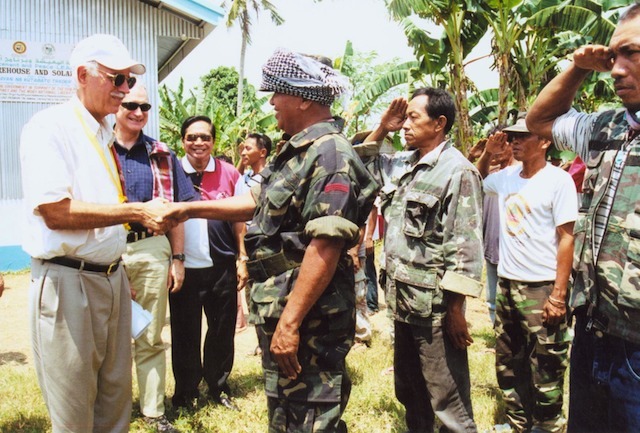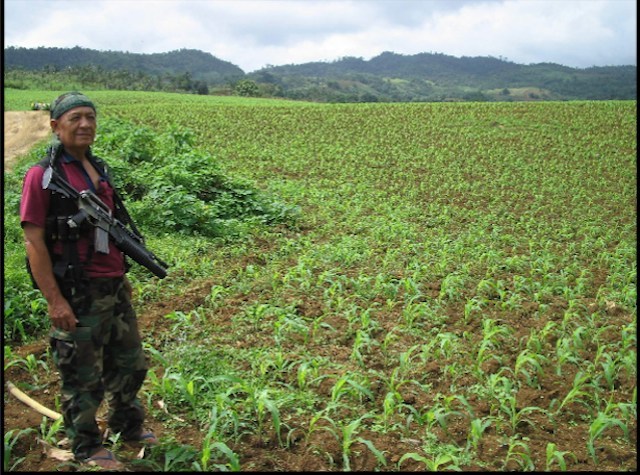'When it comes to economic assistance, communities see US aid as a better and reliable source compared to the Philippine government that had been notorious in breaking promises of bringing development and growth to Muslims'
The Moro National Liberation Front (MINLF) had waged a war of secession against President Ferdinand Marcos after the latter sent the Armed Forces of the Philippines (AFP) to Mindanao shortly after he declared martial law and installed a dictatorship.
With guns and other resources provided by Libya and Malaysia, the MNLF fought a conventional war against the AFP. The separatist movement, however, could not sustain this kind of warfare. After two years of open war, the coalition began to splinter as Marcos, with offers of spoils and a chance to reclaim their local power, was able to coax the politicians who joined the MNLF to go back to the fold and form alternative Bangsamoro (Moro people) organizations to rival the MNLF for Muslim support.
Intra-ethnic tensions also prevailed among the activists, with members from the Maguindanao ethnic groups protesting the domination of the Tausogs in the organizational leadership. Among the Maguindanaos were also commanders who were calling for the organization to abandon its secularism in favor of a political program based on Islamic tenets. They would eventually break from the MNLF and form the Moro Islamic Liberation Front (MILF).
Faced with these internal fissures, and with Libya deciding that it was time to normalize ties with the Philippine government, the MNLF finally agreed to sit down and begin peace talks with Manila. Intermittent clashes (largely chance encounters) continued to happen, but did not detract the two sides from continuously talking. When Marcos fell in 1986, the negotiations sped up after a more democratic regime headed by the extremely popular President Corazon Aquino took over. A peace agreement was eventually signed in 1996.
In exchange for demobilizing its army, the government offered the MNLF control of the Southern Philippines Development Authority (SPDA) and the Autonomous Region for Muslim Mindanao (ARMM), both agencies created by Congress to address the needs of the Muslim minority. Manila also promised to launch a “mini-Marshall plan” for Muslim Mindanao, seeking out the United States, Europe, Japan, the Arab states, and international multi-lateral agencies like the World Bank and the Asian Development Bank for support. The United States was one of the first to respond to this request, and set aside funds for an Emergency Livelihood Assistance Program (ELAP), to be implemented by USAID’s Growth with Equity in Mindanao (GEM), the largest umbrella project implementing investment and infrastructure programs in the island since 1995. USAID likewise tapped its Washington-based Office of Transition Initiatives (OTI) to partner with GEM on the project.

WARM WELCOME. The MNLF welcomes USAID. Photo courtesy of Noel Ruiz
One particularly important factor worth noting is the United States' unique position in the southern Philippines. While popular regard of American presence in Iraq and Afghanistan tends to be very critical and even antagonistic, the reverse is the case when it comes to how Mindanao Muslims view the United States. A positive sentiment towards the USA cuts across classes, ethnic groups, and even political ideologies: those who continue to welcome American presence in Muslim Mindanao include warlords and political clans who expressed delighted that American assistance has finally brought “development” to their constituents through farm-to-market roads, medical clinics, and other infrastructure projects.
They also consist of communities where American aid has been instrumental in reviving primary learning, or improving it through massive book donations and computerization. Pro-American sympathies are even strongly evident inside the MILF, which had gone out of its way to seek out American assistance in its negotiations with the Philippine government. The MILF’s late chairman Hashim Salamat wrote a letter to then President George W. Bush requesting the US government to join Malaysia in mediating the peace talks.
The reasons for this unusual widespread approbation of the Americans range from the instrumentalist to the historical. For politicians and local strongmen, American aid is seen as an “alternative” resource that then “frees” their own largesse and opens this to plunder and spoils. “Ordinary” Muslims see American troops as “buffers” between an oppressive state and embattled minority. The presence of an American soldier, accordingly, would make Filipino troops think twice before doing the sordid things they were infamous of in the past: the massacre of Muslim civilians, the burning of their houses, raping of their women, etc. Moreover, when it comes to economic assistance, communities see US aid as a better and reliable source compared to the Philippine government that had been notorious in breaking promises of bringing development and growth to Muslims.
By keeping Islam out of their military and economic transactions, Americans have likewise gained the respect of Muslims. The first “resistance” to USAID arose from a suspicion that GEM and ELAP were programs that were designed to undermine Islam by introducing “Western” values. This was easily dispelled when USAID repeatedly assured Muslims that its projects were aimed solely at economic and educational development.
USAID – particularly its Filipino and Mindanawon staff – that target communities were aware that they were dealing with communities which were not only Islamic, but also parts of parts thriving trading centers (or were centers themselves) whose histories predated the formation of the Philippines, and whose connections reached out beyond national borders to maritime Southeast Asia itself.

FARMS WITH ARMS. A former MNLF fighter guarding his GEM-supported cornfield. Photo courtesy of Noel Ruiz
By focusing on this “economic side” of Muslims, they tapped into a tradition that was also as old as Islam and which never disappeared even if the modern state began to impose restrictions on this now illicit movement of commodities and people. In the May 21, 2002 issue of Manila Bulletin, Jasmin Agbon, a GEM’s area manager, said: “Everyone’s either a businessman or a farmer. A Muslim vegetable farmer is no different from a Christian vegetable farmer. They have the same problems, they employ the same technology and same marketing tools.”
Neither did USAID touch the MNLF’s guns.
In the development world, one of the primary goals of helping conflict-affected areas is the demobilization and disarmament of former rebels. What official development reports one gets to read in Washington, do not tell readers – for obvious reasons – that the US and the Philippine governments have taken away from the MNLF the right to continue to bear arms. The rebel group’s combatants who joined ELAP were demobilized officially, but they were not asked to surrender their arms, and in several occasions were not hampered from purchasing new and more powerful weaponry, using revenues they generated from USAID-funded programs and the joint US-Philippine military exercises.
Conflict resolution and economic rehabilitation in Muslim Mindanao are therefore premised on rebels-turned-entrepreneurs holding on to their arms while staring back at the Philippine military stationed nearby, over the shoulders of American soldiers standing in between the two former combatants.
Mitigating vigorously any attempt to utilize these arms again was the state of the MNLF itself. When it signed the peace agreement, it was already a considerably weakened movement. Its leadership – by the time of the peace agreement – was split into 4 factions, its armed force composed largely of ageing veterans, spread out in small numbers across Muslim Mindanao, the Sulu Archipelago, and in exile in Borneo, Saudi Arabia and Libya. The peace agreement put a close to the MNLF’s rebellion, and its leaders brought into the fold and were instantly attracted to the power and influence of patronage politics, joining the game of spoils and plunder that was once the domain of “traditional” politicians.

[This is the second part of an abridged report I wrote as a fellow at Washington DC’s Woodrow Wilson International Center for Scholars. (READ: [Part 1] Mindanao rehabilitation: Lessons from the past)]
http://www.rappler.com/thought-leaders/96982-mnlf-united-states-part-2

No comments:
Post a Comment
Note: Only a member of this blog may post a comment.